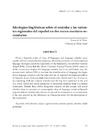Please use this identifier to cite or link to this item:
https://accedacris.ulpgc.es/jspui/handle/10553/5645
| DC Field | Value | Language |
|---|---|---|
| dc.contributor.author | Heros, Susana de los | en_US |
| dc.date.accessioned | 2011-06-23T02:31:00Z | - |
| dc.date.accessioned | 2018-03-07T09:37:44Z | - |
| dc.date.available | 2011-06-23T04:00:28Z | - |
| dc.date.available | 2018-03-07T09:37:44Z | - |
| dc.date.issued | 2007 | en_US |
| dc.identifier.issn | 1133-1127 | en_US |
| dc.identifier.uri | https://accedacris.ulpgc.es/handle/10553/5645 | - |
| dc.description.abstract | From a linguistic point of view, all languages and language varieties serve equally well for communication purposes. However, a number of interconnected language ideologies, assert the superiority of the Standard(s) over all other varieties (Siegel 2006). Given that the Diseño Curricular Nacional Peruano (2005) states its desire to promote respect for language varieties but in an ambivalent way, the present study utilizes CDA to examine the manifestation of language ideologies about language variation, and the value and use of standard and regional dialects of Spanish in two first-year high school textbooks: Talento and Voces. It does so by examining both the content material and the way it is expressed in the text (i.e., word, verbal and mood selections) to determine whether there is a hidden curriculum (Martin Rojo 2000). Linguistic analysis of the texture will reveal whether there is a positive or a prescriptive view of language variation/Spanish regional dialects. Additionally, the two books will be compared so as to determine if the text selected by the Ministerio de Educación better fits the description of the curriculum. | en_US |
| dc.description.abstract | Desde un punto de vista lingüístico todas las lenguas y variedades lingüísticas sirven igual para propósitos comunicativos. A pesar de este hecho, hay una cantidad de ideologías lingüísticas que están interconectadas, y que siguen asumiendo la superioridad de las lenguas o variedades estándares sobre todas las otras variedades (Siegel 2006). Dado que el Diseño Curricular Nacional Peruano (2005) indica como objetivo educativo el deseo de promover el respeto por todas las variedades de lengua en su currículo, pero lo hace de una forma ambivalente, el presente estudio utiliza el método del CDA/ACD (‘Critical Discourse Analysis’ o Análisis Crítico del Discurso) para examinar la manifestación de ideologías sobre la variación lingüística y sobre el valor del uso del estándar y los dialectos regionales del español en dos textos escolares de primer año de secundaria: Talento y Voces. Esto lo hace examinando ambos, el contenido y la forma como este se expresa lingüísticamente en el texto (i.e., uso de palabras, expresiones verbales y selección de modalidad verbal), para determinar si existe un currículo escondido en términos de Martín Rojo (2000). El análisis lingüístico de la textura revelará si en realidad existe una ideología positiva hacia las variedades regionales o si es más bien una visión prescriptiva de la variación del español y los dialectos regionales. Asimismo los dos libros se compararán para determinar si el texto seleccionado por el Ministerio de Educación es en realidad mejor que el otro en términos de cubrir el currículo. | en_US |
| dc.format | application/pdf | es |
| dc.language | spa | en_US |
| dc.relation.ispartof | LFE. Revista de Lenguas para Fines Específicos | en_US |
| dc.source | LFE. Revista de lenguas para fines específicos. Las Palmas de Gran Canaria: Universidad de Las Palmas de Gran Canaria, 1993-.-- ISSN 1133-1127.-- n. 13-14, 2007-2008, p. 93 | en_US |
| dc.subject | 570107 Lengua y literatura | en_US |
| dc.subject | 550510 Filología | en_US |
| dc.subject.other | Critical discourse analysis | en_US |
| dc.subject.other | Regional varieties | en_US |
| dc.subject.other | Peruvian spanish | en_US |
| dc.subject.other | Education | en_US |
| dc.subject.other | Hidden curriculum | en_US |
| dc.title | Ideologías lingüísticas sobre el estándar y las variantes regionales del español en dos textos escolares secundarios peruanos | en_US |
| dc.type | info:eu-repo/semantics/article | en_US |
| dc.type | Article | en_US |
| dc.compliance.driver | 1 | es |
| dc.identifier.absysnet | 233536 | - |
| dc.identifier.crisid | - | - |
| dc.investigacion | Artes y Humanidades | en_US |
| dc.rights.accessrights | info:eu-repo/semantics/openAccess | es |
| dc.type2 | Artículo | en_US |
| dc.identifier.external | - | - |
| dc.identifier.external | - | - |
| dc.identifier.ulpgc | Sí | es |
| dc.description.esci | ESCI | |
| dc.description.erihplus | ERIH PLUS | |
| item.grantfulltext | open | - |
| item.fulltext | Con texto completo | - |
| Appears in Collections: | LFE, Rev. leng. fines específ. n.13-14, 2007-2008 Artículos | |
Page view(s)
489
checked on Feb 15, 2025
Download(s)
235
checked on Feb 15, 2025
Google ScholarTM
Check
Share
Export metadata
Items in accedaCRIS are protected by copyright, with all rights reserved, unless otherwise indicated.
